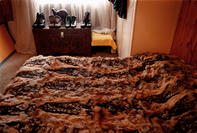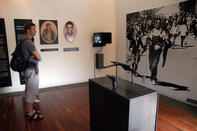Mandela Family Museum
Originally opened by Winnie Madikizela-Mandela, No 8115 Ngakane Street - the tiny three-roomed bungalow where Nelson Mandela, his first wife Evelyn (until their divorce) and subsequently Winnie, lived during the fifties - is now The Mandela Family Museum. It's fascinating to stand in the house and imagine security forces parked on the street outside, to poke your nose into the memorabilia on display, and to remember that at the time it had a bucket toilet out in the yard.
Regina Mundi Church
It's not the 1960s architecture of the Regina Mundi Church that's of significance, even though it's built to seat 6 000, but the events that took place in it during the struggle against apartheid and racial inequality. Attend a service to get a feel for the warm spirit of the Catholic congregation, count the bullet holes in the ceiling and light a candle in thanks for the continuing miracle that is post-apartheid South Africa.A Two-day Gathering
In 1955 (25 and 26 June), a two-day gathering at Kliptown in Soweto was held by the Congress of the People. It was perhaps the most democratic party ever in the history of South Africa. Some 3000 delegates, a multiracial coalition of anti-apartheid organisations, came together to map out the future of the political struggle, as well as its political philosophy.
As was the case with the American Declaration of Independence, we can be glad of the unbelievably high calibre of the people who drew up the Freedom Charter in that square, because it defined not only the multiracial and democratic nature of the struggle, but was also the foundation of the visionary constitution we enjoy today.
“We, the People of South Africa, declare for all our country and the world to know: that South Africa belongs to all who live in it, black and white and that no government can justly claim authority unless it is based on the will of all the people”.
16 June 1976

If one day can be said to have been the fulcrum of modern South African history, it must be when the black political struggle emerged from prisons and dark rooms into the streets to become a true mass movement. This was the tidal wave the white minority government had always feared, which, once unleashed, could not be stemmed, no matter what preventative measures were enforced.
And enforced they were, amping up the conflict and leading to the imposition of successive 'states of emergency' - all of which only prolonged the inevitable. Although Soweto was the focal point of dissent on that June day (it began as a protest against 'bantu education'), unrest quickly spread to every corner of the land.
The monument where Hastings Ndlovu, the first slain school child, fell could be called ground zero (although the most famous photograph of that day depicts another slain youth, Hector Pieterson), but other nearby sites such as Regina Mundi Church and Nelson Mandela's house in Orlando West are equally significant.